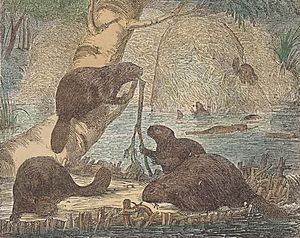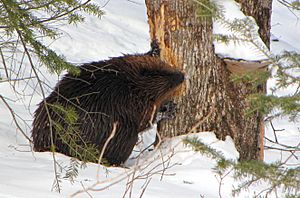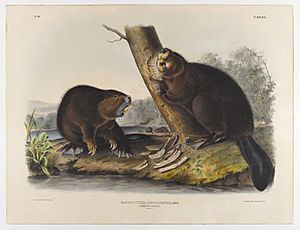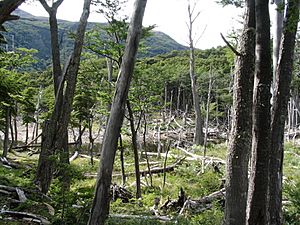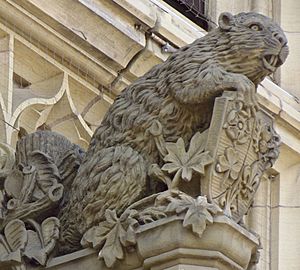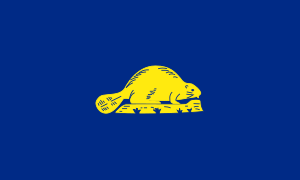North American beaver facts for kids
Quick facts for kids North American beaver |
|
|---|---|
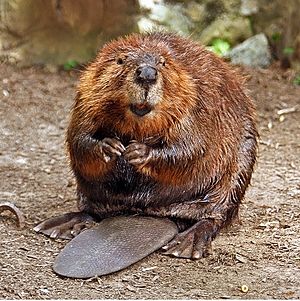 |
|
| A male North American beaver | |
| Conservation status | |
| Scientific classification | |
| Genus: |
Castor
|
| Species: |
canadensis
|
| Subspecies | |
|
List
|
|
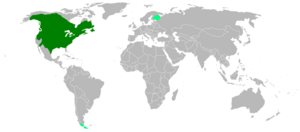 |
|
| Distribution of the North American beaver (dark green – native, light green – introduced) | |
| Synonyms | |
|
Castor fiber canadensis |
|
The North American beaver (Castor canadensis) is one of two living beaver species. The other is the Eurasian beaver (Castor fiber). North American beavers live in North America. They have also been brought to parts of South America (Patagonia) and Europe (mainly Finland and Karelia).
In Canada and the United States, people often call this animal simply "beaver". The North American beaver is one of Canada's official national wildlife of Canada symbols. It is also the official state mammal of Oregon and New York.
Contents
About North American Beavers
Physical Features of Beavers
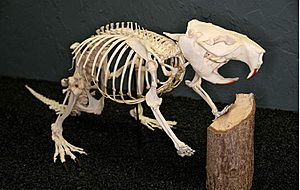
The beaver is the largest rodent in North America. It is the second-largest rodent in the world, after the capybara from South America. Adult beavers usually weigh from 11 to 32 kilograms (24 to 71 pounds). A typical adult weighs about 20 kg (44 lbs). Beavers in colder northern areas tend to be larger.
Adult North American beavers are about 74 to 90 centimeters (29 to 35 inches) long. Their tail adds another 20 to 35 cm (8 to 14 in) to their length. Very old beavers can grow much larger, sometimes weighing over 40 kg (88 lbs).
Beavers spend a lot of time in the water. They have many features that help them live in water.
- They have a large, flat, paddle-shaped tail.
- Their back feet are large and webbed, like a duck's foot.
- Their front paws are smaller and have claws. They use these paws for digging and holding things.
- Their eyes have a special clear eyelid, called a nictitating membrane, that lets them see underwater.
- Their nostrils and ears close tightly when they go underwater.
- They can close their lips behind their front teeth. This lets them chew on wood even when they are underwater.
- A thick layer of fat under their skin keeps them warm in cold water.
A beaver's fur has two layers: long, coarse outer hairs and short, fine inner hairs. The fur is usually dark brown. Beavers have special glands that make an oily substance called castoreum. They use this to make their fur waterproof. Beaver fur was once very popular for making hats. This led to beavers being hunted almost to extinction. Luckily, styles changed, and beavers were saved.
Beavers have front teeth (incisors) that never stop growing. They are also hindgut fermenters. This means they have a special part of their gut, called a cecum, with helpful bacteria. These bacteria help them digest the tough plant material they eat.
Where Beavers Live
Before they were heavily hunted, beavers lived almost everywhere in North America. They lived from the cold tundra in the north to the deserts of northern Mexico. They were found from the Atlantic Ocean to the Pacific Ocean. Today, their populations are growing again in many areas. Beavers have even started moving into the arctic tundra. This is likely because of climate change, which causes more shrubs to grow near rivers there.
Beavers have been seen in Mexico, along rivers like the Colorado River and Sonora River.
Beaver Behavior

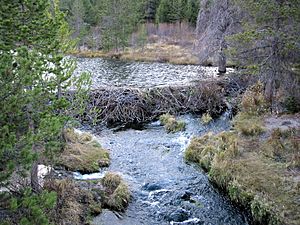

Beavers are mostly active at night. They are excellent swimmers and can stay underwater for up to 15 minutes. They are safer in the water than on land, so they try to stay submerged as much as possible. Their flat, scaly tail is used to slap the water's surface to warn others of danger. It also stores fat.
Beavers build their homes, called "lodges," using sticks, twigs, rocks, and mud. These lodges can be in lakes, streams, or river deltas. Some lodges are surrounded by water, while others are burrows dug into river banks. Beavers are famous for building dams across streams. They then build their lodges in the artificial ponds that form behind the dams.
When building a lodge in a pond, beavers first make a pile of sticks. Then, they chew out underwater entrances and two platforms inside the pile, above the water. One platform is for drying off. As winter approaches, they often cover the lodge with mud. When this mud freezes, it becomes as hard as concrete. They leave a small air hole at the top of the lodge.
Building Dams
The main reason beavers build dams is to create deep water. This deep water helps them escape from predators. If a lake or large river already has deep water, beavers might just dig a burrow in the bank with an underwater entrance.
Beaver dams are made of branches from trees the beavers cut down. They also use rocks, grass, and mud. If there isn't much wood, beavers might build their dams mostly from rocks. The inner bark, twigs, shoots, and leaves of these trees are also important food for beavers. Beavers cut down trees using their strong front teeth. They use their front paws to dig, carry, and place materials. The sound of running water tells a beaver where and when to build its dam.
Beaver ponds are not just safe homes for beavers. They also create habitats for waterfowl, fish, and other water animals. Beaver dams help stop soil erosion and can reduce flooding. However, beaver dams need beavers to keep them in good repair. Beavers usually focus on building and fixing dams in the fall, getting ready for winter.
The largest beaver dam ever found is 2,790 feet (850 meters) long. That's more than half a mile! It was discovered by satellite in 2007 in Wood Buffalo National Park in Alberta, Canada. It is more than twice the width of the Hoover Dam.
Normally, dams create water deep enough so it doesn't freeze solid in winter. The dams also flood nearby forest areas. This gives beavers safe access to food like leaves, buds, and the inner bark of trees. In cold places, beavers also build a food storage area, called a cache. They gather tree branches in late fall and store them underwater. They stick the chewed ends of the branches into the mud at the bottom of the pond. This way, they can reach the food all winter. Often, the pile of food branches sticks out above the pond and collects snow. This snow helps insulate the water below, keeping that part of the pond from freezing. Beavers can swim from their lodge under the ice to get to their food cache. In warmer areas, they don't need to store as much food for winter.
Building Canals
Beavers also build canals. These canals help them float logs to their pond. Dams might also be used to keep the water levels in these canals steady. Beavers build canals to reach more food resources, move materials easily, and stay safe from predators. Some beaver canals can be over 0.5 kilometers (0.3 miles) long. Beavers build canals by pushing through soil and plants with their front paws.
Scientists think that beaver canals are not just for transport. They might also be an extension of the beaver's "home base" around its lodge or food cache. A study in 2012 found that beavers cut down trees closer to their canals than to the main body of water. This suggests that beavers see canals as part of their main foraging area.
Beaver Communication and Family Life
Beavers have many ways to communicate. They use scent marking, different sounds, and tail slapping. Beavers leave their scent (castoreum) on piles of mud and debris called scent mounds. These mounds are usually near lodges, dams, and trails close to the water. A single beaver territory can have over 100 such mounds.
Beavers make several sounds, including a whine, hiss, and growl. They use sounds and tail slapping to ask for food, warn family members about predators, or scare away threats.
Beavers live in family groups. Baby beavers, called "kits," are born with fur and can do many things right away. Young kits usually stay with their parents for up to two years. They learn how to build dams and other important skills from their family.
What Beavers Eat
Beavers are herbivores, meaning they eat plants. They eat a mix of soft plants and woody plants. Their diet changes depending on the region and the season. They prefer aspen and other poplar trees. They also eat birch, maple, willow, alder, and some other trees. They also enjoy cattails, water lilies, and other water plants, especially in spring. Contrary to what some people think, beavers do not eat fish.
Beavers choose their food based on taste, shape, and smell. They eat wood, bark, branches, twigs, roots, buds, leaves, and stems. In some cases, they even eat the sap of certain trees.
When soft plants are growing, they make up a large part of the beaver's diet. In winter, beavers switch to woody plants and the food they stored. Willow is an important food source, especially in the far north. When available, aspen and poplar are preferred over willow. Beavers also cut down conifer trees for food or building materials.
Beavers don't always use the same trees for building and eating. They might use inedible wood for the top of their food cache, which freezes in the ice. The actual food cache is made of tasty, high-quality branches that stay unfrozen and easy to reach. Beavers tend to avoid red maple trees. Sometimes, these are the only trees left standing around a beaver pond.
Beaver Predators
Common natural predators of beavers include coyotes, wolves, and mountain lions. American black bears might also hunt beavers, sometimes by breaking into their lodges. Wolverines, Canada lynx, bobcats, and foxes might attack smaller or sick beavers. American alligators rarely threaten beavers. Large birds like golden eagles and bald eagles might sometimes prey on small beaver kits.
Differences from European Beavers
North American beavers look similar to European beavers (Castor fiber), but they have some key differences.
- North American beavers are usually a bit smaller.
- They have smaller, more rounded heads.
- Their snouts are shorter and wider.
- Their underfur is thicker, longer, and darker.
- Their tails are wider and more oval-shaped.
- They have longer shin bones, which helps them stand on two legs more easily than European beavers.
- Their fur color is also different. About 50% of North American beavers have pale brown fur, while 66% of European beavers have pale brown or beige fur.
The two species cannot have babies together. North American beavers have 40 chromosomes, while European beavers have 48. Even when scientists tried to breed them, it didn't work. This means they are unlikely to breed in places where both species live.
Beavers and Their Environment
Beavers were once hunted almost to extinction in North America. Their fur and a substance called castoreum were highly valued. In the early 1600s, thousands of beavers were trapped each year for the fur trade. This hunting drove beavers to the edge of extinction. The search for beaver fur even helped drive the exploration of western North America.
Thanks to protection efforts in the late 1800s and early 1900s, the beaver population has grown back. Today, there are an estimated 10 to 15 million North American beavers. This is still much less than the 100 to 200 million beavers that lived before the fur trade.
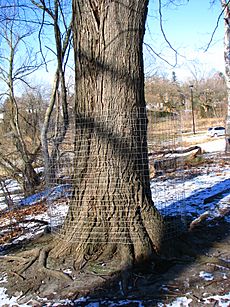
Sometimes, beavers are seen as pests. Their dams can cause flooding, and they cut down trees that might be important to people. Because beavers are very good at fixing their dams, people used to move them or get rid of them. Now, there are non-harmful ways to manage beaver-related flooding. One method uses special pipes called "beaver deceivers" or levelers.
Beavers are a keystone species. This means they are very important to their environment. By creating ponds and wetlands, they increase the variety of life (biodiversity) in their area. When wetlands form, new water plants grow. This attracts more insects, fish, mammals, and birds.
Beavers and Humans
Beavers as Introduced Species
In the 1940s, beavers were brought to Tierra del Fuego in southern Chile and Argentina. This was for fur farming, but the business failed. About 25 pairs of beavers were released into the wild. Since they had no natural predators there, their numbers quickly grew to 100,000 in just 50 years.
These beavers are considered an invasive species. However, some recent studies show they can also have good effects on native fish. For example, areas with introduced beavers had more native puye fish. Beavers have also crossed saltwater to reach the Chilean mainland. Because they change the environment so much, many scientists think they should be removed from this region.
North American beavers were also released in Finland in 1937. At the time, people didn't know they were a different species from European beavers. The European beavers had disappeared from Finland, so the idea was to bring beavers back. By 1999, about 90% of beavers in Finland were the American species. However, in Europe, American beavers have a similar positive effect on the environment as European beavers. Their population is managed by hunting licenses.
Beavers as Food
Beaver meat tastes similar to lean beef. It is usually slow-cooked in a broth. Beaver meat was an important food source for Native Americans. Early French Canadian Catholics even considered beaver to be "four-legged fish" that could be eaten during Lent.
Beaver Symbolism
The North American beaver is one of Canada's national symbols. It is shown on the Canadian nickel coin. The beaver was also on Canada's first postage stamp, the "Three Penny Beaver." This was the first postage stamp to show an animal instead of a head of state.
The beaver is also the state animal of Oregon and New York in the United States. It is a common mascot for engineering schools, like the California Institute of Technology and the Massachusetts Institute of Technology. It also appears on the back of the state flag of Oregon. The beaver is also part of the coats of arms for the Hudson's Bay Company, the University of Toronto, and the London School of Economics.
The early economy of New Netherland (now New York) was largely based on the beaver fur trade. Because of this, the seal of New Netherland featured a beaver. The coats of arms of Albany, New York and New York City also include the beaver.
See also
 In Spanish: Castor americano para niños
In Spanish: Castor americano para niños




